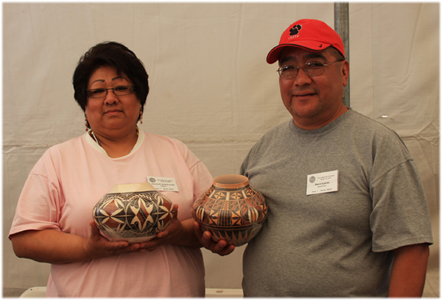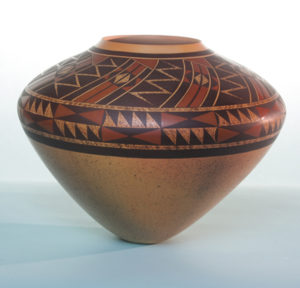Steve Lucas

Steve Lucas, Hopi potter, has emerged as one of the premier artists from the Nampeyo family. He has consistently won blue ribbons at the most prestigious shows in the pottery field, Santa Fe Indian Market and Gallup Ceremonial, just to name two of the most illustrious shows.
Steve Lucas has the Hopi name of Koyemsi, Hopi-Tewa for the mudhead clown, the clan to which he belongs on Hopi First Mesa. This name and the mudhead logo appear on the base of each of Steve’s pots. You will find, simultaneously, the corn logo, symbol of the Corn clan, the clan of Nampeyo, Steve’s great, great-grandmother.
Before any ideas are thought of, Steve must first dig clay from the surrounding Mesa areas on the Hopi Reservation. There is no need to add temper, a substance which helps the clay hold together, since the clay on the Reservation is naturally tempered. The next step is to soak the clay in water to hydrate so the rocks, weeds, and other foreign debris can be removed. Clay is then strained through the legs of an old pair of jeans, allowed to sit, and then water is skimmed off until the proper consistency is reached. The next step is to knead, knead, knead. If not kneaded thoroughly, then the pottery will blow up during firing! Clay preparation is a key step. Good straining and preparation will give Steve the best clay to work with!
Then the molding process begins. Steve uses the traditional method of coiling, pinching and scraping. He begins with a puki bowl to form the bottom of his pottery, then works up from there. Steve decides the shape once he has begun coiling. Often times, the clay shapes itself. He has found that if he sets out to make a small pot, it doesn’t come out small. After the pot has dried, that’s when the sanding begins. Traditionally, Hopi have made very thin-walled pots. While very attractive to the buyer, it is a challenge for the potter to make the walls thick enough so that they can’t be sanded through. Drawing the designs. Most often Steve does have a design decided previously. Once he begins drawing with pencil on the pot, he has to leave himself and the design open for changes. The size and style of the pot certainly influence the drawing so it is often necessary to make adaptations. Designs don’t always come easily. If he gets stuck, he’ll put the piece away and work on something else.
Polishing takes several hours or more if it’s a larger pot. Painting begins once the polishing is complete. All of the paints are vegetal. For instance, the black paint comes from wild spinach. Steve picks it, boils it, lets it dry, then mixes it to the right consistency so that it will not come off during or after firing. The final step is firing. Steve begins with a screen over the wood and manure, then pot shards to cover his new pottery and protect it from taking on too much heat. He adds more manure for fuel and sprinkles cedar for good luck. Interesting fact here is that Steve prefers to buy manure in Summer. Winter sheep manure tends to be thicker and denser thus burning hotter and longer causing more blow ups. You can say he knows his “manure”. After several hours, when the fire has burned down, Steve carefully unveils his new creation. The tension and uncertainty is relieved when Steve pulls out a beautiful pot, unscathed and intact!
Steve’s wife Yvonne of Laguna, makes beautiful pottery using similar procedures as Steve but focusing on designs from her Laguna heritage.
Showing the single result

